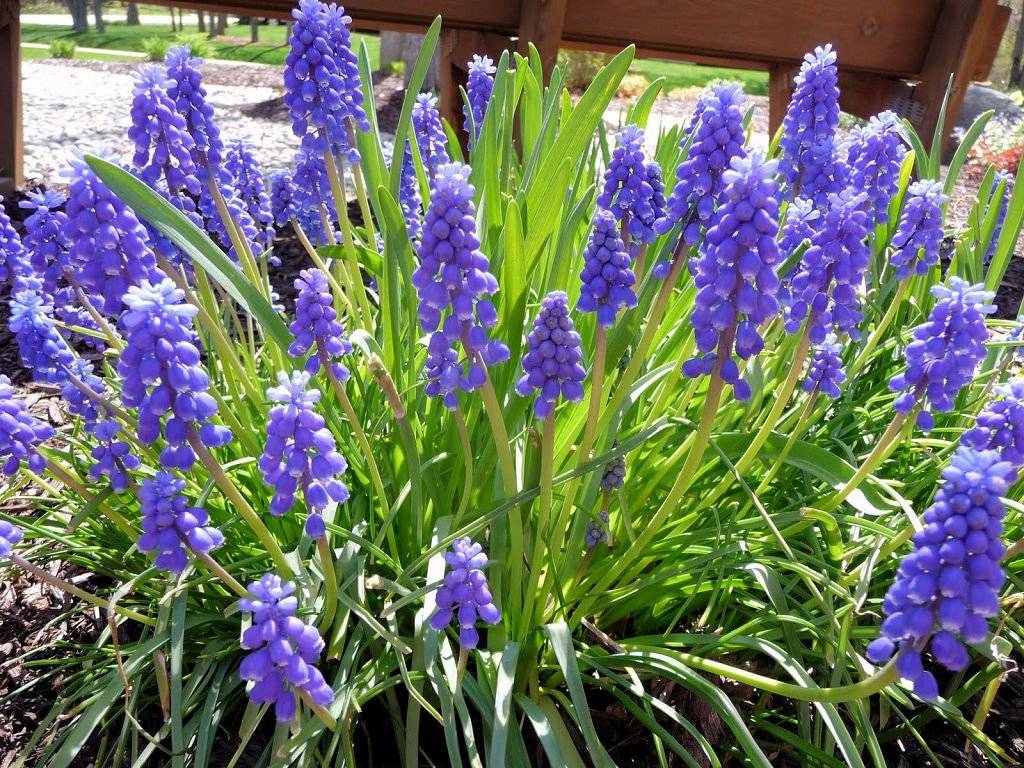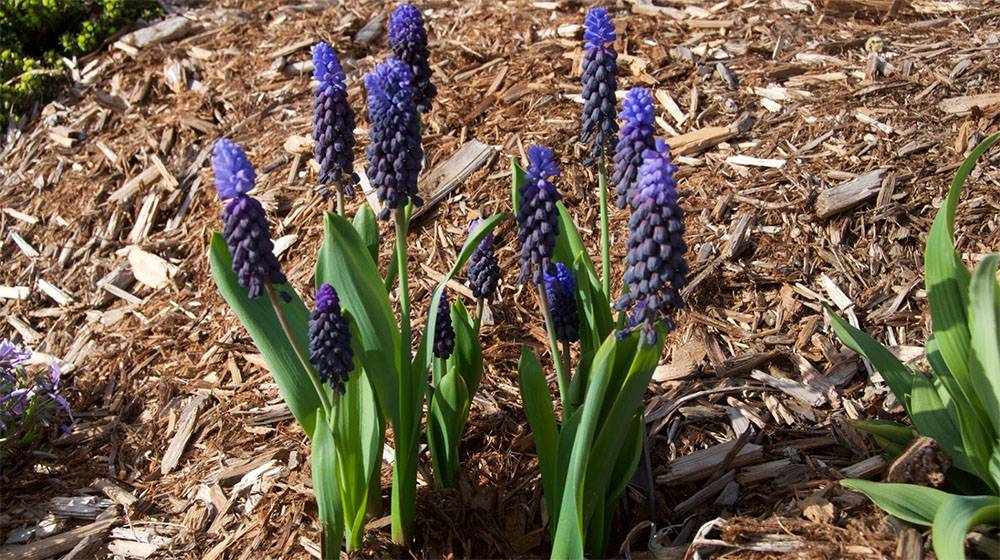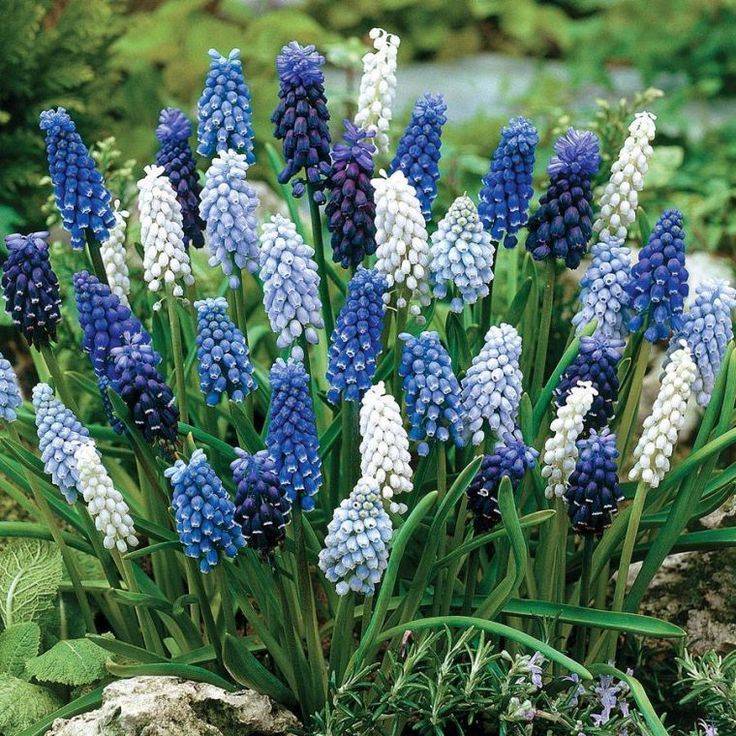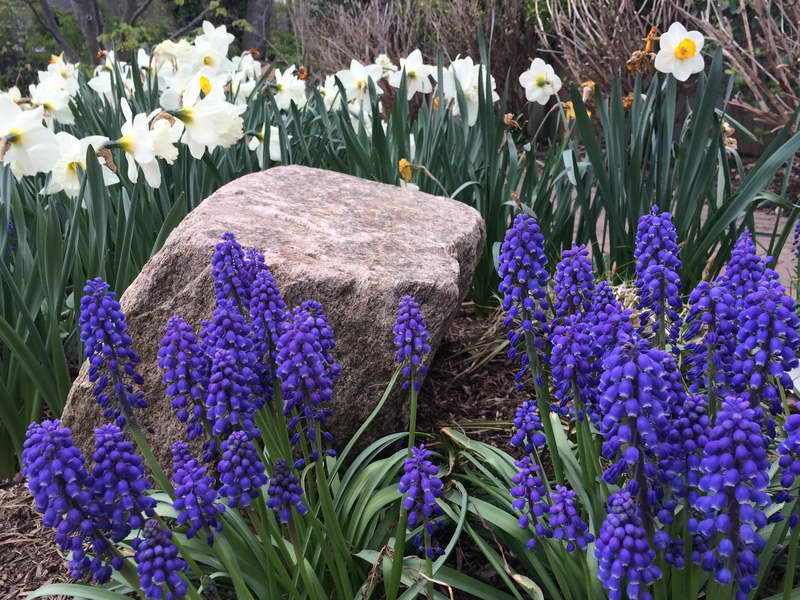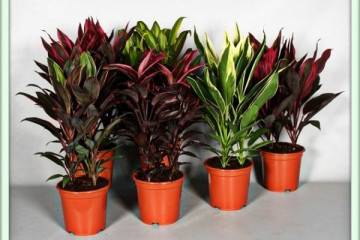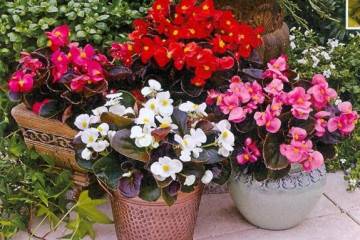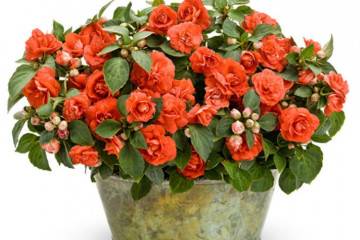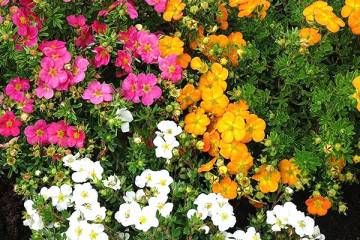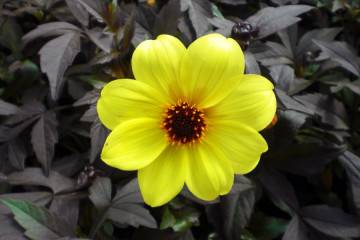Muscari flowers - varieties and types, cultivation
Content:
Muscari (mouse hyacinth) belongs to the category of flowering ornamental plants. Flowers are often used by landscape designers when landscaping local areas. Graceful plants can become a decoration of a loggia or a plot in the garden. Mouse hyacinths allow you to create compositions that are distinguished by originality and tenderness. Green spaces gained wide popularity due to the absence of difficulties in care, the amazing beauty of plants during the flowering period, the ability to develop well in a variety of conditions.
Description of the flower
There are a number of distinctive features that make it easy to recognize muscari among other colors. The culture bulbs are naturally endowed with oval outlines. Their length reaches 3 cm, and the diameter does not exceed 2 cm. The height of the mouse hyacinth is in the range of 28-30 cm. The sheet plates of the rectilinear type grow up to 12-15 cm. Each rosette contains 8-10 pcs. Peduncles are bare.
Inflorescences can be colored in different tones, namely:
- blue;
- azure;
- lilac;
- purple;
- pink;
- white;
- yellow.
Small bulbous perennial plantings are early flowering crops. You can admire the gorgeous flowering for only 10-14 days.
Among the main advantages of muscari are:
- good adaptation to a variety of living conditions;
- increased endurance;
- easy care.
Popular varieties
In the genus of mouse hyacinth, experts have about 44 varieties. Most of them are endowed with a naturally chic appearance, which allows landscape designers to use them when landscaping a site. Below you can find the most popular muscari varieties.
- Armenian muscari (muscari Armeniacum) is a fairly common variety among flower growers, which is distinguished by the formation of large multi-flowered inflorescences. Each inflorescence contains 48-50 buds. You can admire the blossoming flowers from mid-May to late spring. Flowers of the Armenicum variety are painted in a bright blue palette. In the area of the outer parts of the petals, a white border is formed. During the flowering period, an amazingly pronounced aroma emanates from the culture. The Armenian variety contains several varieties of flowers. The most spectacular are Alba, Sapphire and Blue Spike.
- Plumosum (Muscari Plumosum) is an ornamental culture, the height of which reaches 18-20 cm. The flowering of the variety is quite lush. The length of the spikelets is within 7-8 cm. On one side of the flowers there are large pedicels, which form a crest on the inflorescence. Each bud is colored in a blue-violet palette. The buds begin to bloom towards the end of spring. The spikelet arrows grow, and by the end of flowering, their length can reach 70 cm.
- The grape-like muscari is a bulbous plant, the height of which reaches 14-15 cm. In the area of the tips of the arrows, dense spike-shaped inflorescences are formed. The buds of the variety are rather small. They are painted in white or pink shades and are tightly pressed against each other.Album (with white flowers), Рink Sunrise (Pink Sunrise, soft pink double flowers), Surprise became the best types of bunch-shaped flowers.
- Broadleaf muscari is a variety that is distinguished by the formation of wide leaf plates, which in appearance resemble the outlines of tulip foliage. On each plant, several peduncles appear with the presence of dark blue, small-sized, barrel-shaped buds. This muscari, planting and caring for which is not difficult, can become a real decoration of the flower bed.
Such varieties as look quite impressive on a flower bed:
- muscari Azureum;
- Muscari Valerie Finnis;
- muscari Latifolium.
Muscari: planting and grooming outdoors
To plant Muscari flowers, as they are also called, you need to purchase the seeds or bulbs of the plant. For beginners in the field of floriculture, experts recommend giving preference to the second option.
Planting operations should be planned for the last days of August.
When choosing a place for planting, it is necessary to give preference to areas well-lit by the sun's rays with the presence of loamy soil. Areas located on slopes should be avoided.
Step-by-step planting process:
- The soil in the zone selected for planting is dug up.
- A small part of compost, humus and ash must be added to the soil.
- Holes are made in the ground, the depth of which is 7-8 cm.The recommended distance between the holes is 15 cm.
- A small layer of sand is poured onto the surface of the bottom of the depressions, which will act as drainage.
- An onion is placed in each hole. The pits are filled with soil mixture.
After planting, it is important to systematically moisten the soil. Muscari is a flower that loves water, and it will bloom profusely in any area.
Watering and loosening the soil
The soil in the area of planting flowers should be constantly slightly damp. However, at the same time, stagnation of the liquid should not be allowed in order to prevent rotting of the root system. Irrigation is usually carried out in the morning.
After watering, it is recommended to weed the weed and loosen the soil. Timely removal of weeds allows you to achieve the most abundant flowering, because plants will be able to fully receive useful substances from the soil.
Reproduction methods
As described above, muscari can be propagated by seed and bulbs. In addition, flowers have the ability to reproduce by self-seeding. To control the number of ornamental crops, it is recommended to remove the peduncles after the green spaces have faded, leaving only the required number of pieces.
In the case of planting seed in early autumn, the first shoots can be expected in spring. At first, the sprouts will resemble the appearance of thin threads. The first flowering will occur in the 2-3 year of the plant's life.
Top dressing and fertilizers
To maintain active growth, to achieve the brightest and most abundant flowering, it is necessary to systematically apply top dressing to the soil. In the spring, when digging a site into the soil, organic fertilizer is added. For each square meter, you will need 4.5 kg of top dressing.
To compensate for the lack of nutrients, it is recommended to add a small part of the compost to the soil in the fall, which will enable the bushes to survive the severe frosts in winter.
Plant transplant
Strongly growing perennials can be divided and transplanted into new areas. Taking a shovel, you need to dig out a bush and carefully remove the bulbs, keeping a layer of soil on them. It should be borne in mind that the root system of the flower is fragile, so do not shake off the bulbs. After transplanting, it is necessary to moisten the soil abundantly.
When to transplant muscari? Transplant work is best carried out in October, when the period of active growth is over.
Pests and diseases
Often, mouse hyacinth suffers from a mosaic that occurs against the background of the yellow bulb dwarf virus. Infection is indicated by the appearance of green streaks on the leaf plates. The foliage becomes narrower, the flower arrows are greatly shortened, the growth of the culture slows down. In addition, infection with cucumber mosaic is possible, in which the leaf plates are deformed, and strokes and spots appear on the surface. The main carrier of the virus is aphids. It is impossible to cure the affected plant, so the bushes are dug up and destroyed, which prevents the spread of the virus.
In order to prevent diseases, experts recommend spraying plantations that help destroy aphids. For this purpose, you can use soapy water. To do this, you need to mix 450 ml of water and a couple of tablespoons of Faery dish detergent.
In the event of an invasion of a decorative culture of a spider mite, the plantings should be treated as soon as possible with preparations of the avermectin group:
- actofit;
- vertimek;
- fitoverm.
Flowering period
Murine hyacinth bloom lasts about 10-17 days. The perennial does not require special care at this time. However, it is very important to systematically moisten the soil, remove weeds from the site and cut off wilting inflorescences.
What to do after flowering muscari? If the quality characteristics of flowers have deteriorated, it is necessary to transplant the plantings to a new place.
Preparing for winter
Muscari (mouse hyacinth) withstands severe frosts quite firmly. Dry soil with dead leaf blades is an excellent shelter for bulbs during the winter. Plants do not need additional shelter.
Storing the bulbs
There is no need to dig up the bulbs for the winter, however, many growers still dig them up before the onset of frost. Below you can find the main recommendations for saving planting material in the winter.
- When to dig up the muscari? The bulbs are best dug out at the time of the complete drying of the leaf plates.
- After digging, the planting material is dried for 24 hours.
- Wooden boxes are filled with a layer of moistened peat. The bulbs are stacked in boxes on top of it.
- Every 7-8 days, the florist must inspect the planting material. Decaying, injured or soft bulbs can be thrown away without regret.
- The boxes are transferred to a room where the temperature is in the range of 16-18 ° C, and the air humidity reaches 70%.
Use in landscape design
Mouse hyacinths are actively used by landscape designers when landscaping a garden plot, lawn, rabatka, rock garden, garden paths.Low-growing ground cover grasses in combination with muscari will create a unique composition. Muscari also looks spectacular in a flower bed with growing nearby:
- tulips;
- hazel grouses;
- primrose;
- daffodils;
- crocuses.
Muscari - flowers that can become a real highlight of the site. Flowers are often cut from the flower bed and create unique compositions or bouquets. The inflorescences can only be cut off when the lower flowers have begun to open. Compliance with the recommendations of specialists listed in the article regarding care will help to grow healthy bushes, pleasing with bright and abundant flowering.
